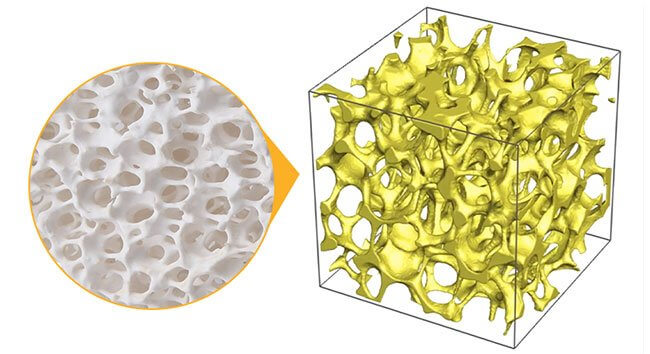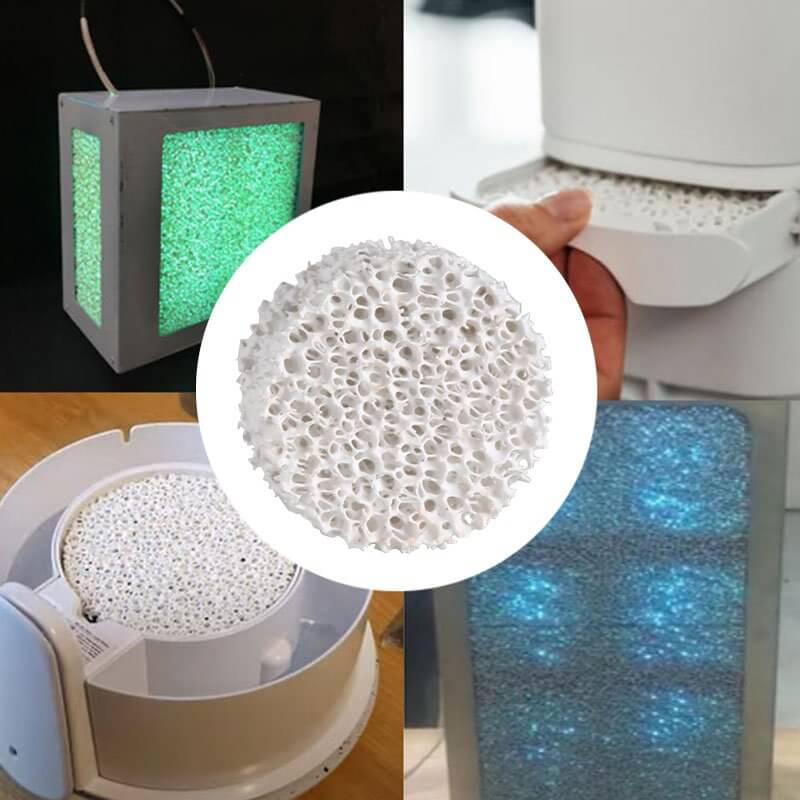Introduction:
Porous alumina ceramics, also known as porous aluminum oxide ceramics, are a class of advanced materials with a wide range of applications across various industries. These ceramics are characterized by their unique microstructure, featuring a network of interconnected pores within a dense ceramic matrix. This article aims to explore the properties, applications, and recent advances in alumina ceramics, shedding light on their versatility and importance in modern technology and engineering.
I. Properties of Porous Alumina Ceramics:
A. Microstructure:
Pore Size and Distribution: Porous alumina ceramics possess a well-controlled pore size distribution, ranging from nanometers to micrometers, allowing tailoring for specific applications.
Porosity Levels: The porosity of these ceramics can be adjusted to achieve desired levels, typically ranging from 20% to 80%.

B. Mechanical Properties:
High Hardness: Porous alumina ceramics exhibit excellent hardness, making them suitable for wear-resistant applications.
Low Density: Despite their high hardness, porous ceramics are relatively lightweight due to their porous structure.
C. Thermal Properties:
High Melting Point: Alumina ceramics have a high melting point, typically above 2000°C, ensuring stability at high temperatures.
Thermal Insulation: The porous structure provides thermal insulation properties, making them valuable in applications where temperature control is essential.
D. Chemical Resistance:
Inert Behavior: Porous alumina ceramics are chemically inert and resistant to most acids, bases, and corrosive chemicals.
Non-toxic: Alumina is non-toxic, making these ceramics suitable for use in biomedical and food-related applications.
II. Manufacturing Methods for Porous Alumina Ceramics:
A. Templating Method:
Replica Technique: This method involves using a template material with a pre-designed pore structure to create the desired porous alumina ceramic.
Template Removal: After sintering, the template is removed, leaving behind the interconnected pores in the alumina ceramic.
B. Starch Consolidation Method:
Starch as a Binder: Starch is used as a binder, which is later burnt out during sintering to create the porous structure.
Control of Porosity: The porosity of the ceramic is controlled by adjusting the starch content in the ceramic mixture.
C. Direct Foaming Method:
Foaming Agents: Direct foaming involves incorporating foaming agents that generate gas bubbles during processing, resulting in the porous structure.
Precise Pore Control: This method allows for precise control over the size and distribution of pores.
III. Applications of Porous Alumina Ceramics:
A. Filtration and Separation:
Membrane Filters: Porous alumina ceramics serve as effective membrane filters in various industries, including water treatment and wastewater purification.
Gas Separation: The controlled pore size allows for selective gas separation and purification applications.
B. Biomedical Applications:
Bone Implants: Porous ceramics find use as bone implants and scaffolds due to their biocompatibility and ability to support tissue growth.
Drug Delivery Systems: These ceramics act as carriers for controlled drug release, ensuring precise and targeted drug delivery.
C. Catalysis and Chemical Industry:
Catalytic Supports: Porous alumina ceramics serve as catalyst substrates, providing a large surface area for catalytic reactions in the chemical industry.

Refining Processes: In petroleum refining, these ceramics aid in various catalytic reforming and desulfurization processes.
D. Thermal Insulation:
High-Temperature Applications: Porous alumina ceramics offer exceptional thermal insulation in high-temperature environments, such as in kilns and furnaces.
Heat Shields: They are used as heat shields in aerospace and automotive industries to protect sensitive components from extreme temperatures.
IV. Recent Advances in Porous Alumina Ceramics:
A. Enhanced Mechanical Properties:
Nanostructured Ceramics: Introducing nanoscale features and reinforcing agents to improve the mechanical strength and toughness of porous ceramics.
Nano-laminated Composites: Layered structures with varying compositions enhance mechanical properties for specific applications.
B. Tailored Pore Architectures:
Hierarchical Pores: Recent advancements allow the creation of hierarchical pore architectures, enabling improved fluid flow and filtration efficiency.
Gradient Pore Size: Controlled gradients of pore size enhance filtration performance in specialized applications.
C. Additive Manufacturing:
3D Printing: Additive manufacturing techniques enable the fabrication of complex geometries and intricate pore structures for personalized applications.
Customization: 3D printing allows for the precise tailoring of porous alumina ceramics to meet specific requirements.
V. Future Outlook:
Porous alumina ceramics continue to hold immense promise in various fields, including filtration, biomedicine, catalysis, and thermal insulation. With ongoing research and development, the properties of these ceramics can be further optimized, opening up new possibilities and applications. The integration of advanced manufacturing methods, nanotechnology, and additive manufacturing techniques will play a significant role in shaping the future of porous ceramics, driving innovation and supporting advancements in diverse industries.
VI. Environmental Applications:
A. Water Filtration and Purification:
Municipal Water Treatment: Porous alumina ceramics are widely used in municipal water treatment plants for removing impurities, bacteria, and contaminants, ensuring access to safe drinking water.
Industrial Wastewater Treatment: These ceramics play a crucial role in treating industrial wastewater, reducing pollutants before discharge, and promoting environmental sustainability.
B. Air Filtration:
Indoor Air Quality: Porous ceramics are incorporated into air purifiers and HVAC systems to trap particulate matter and harmful pollutants, enhancing indoor air quality.
Automotive Emission Control: These ceramics are utilized in catalytic converters to reduce harmful emissions, contributing to cleaner air and reduced environmental impact.
C. Carbon Capture:
Porous Structure for Adsorption: The controlled pore structure of alumina ceramics can be tailored for carbon capture applications, helping mitigate greenhouse gas emissions.
VII. Electronics and Semiconductor Industry:
A. Insulating Substrates:
Circuit Boards: Porous alumina ceramics are used as insulating substrates for printed circuit boards (PCBs), providing electrical insulation and thermal stability.
High-Power Electronics: Their ability to handle high temperatures makes them suitable for power electronics, where efficient heat dissipation is essential.
B. MEMS Devices:
Microelectronics: Porous ceramics are utilized in microelectromechanical systems (MEMS) for various applications, including sensors, actuators, and resonators.
VIII. Energy Storage and Conversion:
A. Lithium-Ion Batteries:
Separator Material: Porous alumina ceramics can serve as separators in lithium-ion batteries, improving their safety and thermal stability during charging and discharging.
Electrodes: Their high surface area and thermal conductivity make them potential candidates for battery electrodes, enhancing battery performance.
B. Fuel Cells:
Electrolyte Supports: Porous ceramics can be used as electrolyte supports in fuel cells, contributing to efficient ion transport and improved cell performance.
IX. Aerospace and Defense:
A. Thermal Protection:
Heat Shields: Porous alumina ceramics are applied as heat shields in spacecraft, protecting them during re-entry into the Earth’s atmosphere.
Thermal Insulation: Their thermal insulation properties make them valuable components in high-temperature aerospace applications.
B. Ballistic Armor:
Lightweight Protection: Alumina ceramics offer lightweight ballistic protection, making them suitable for use in body armor and vehicle armor systems.
X. Advancements in Manufacturing:
A. 3D Printing and Porous Alumina Ceramics:
Complex Geometries: Additive manufacturing allows for the fabrication of complex, intricate, and customized porous alumina ceramic structures for specific applications.
Rapid Prototyping: 3D printing enables rapid prototyping, facilitating the iterative design and optimization of porous alumina ceramic components.
B. Hybrid and Multifunctional Materials:
Hybrid Composites: Porous ceramics can be combined with other materials, such as polymers or metals, to create hybrid composites with enhanced properties.
Multifunctional Integration: These hybrid materials may exhibit multiple functionalities, such as improved mechanical strength and electrical conductivity.
XI. The Role in Emerging Technologies:
A. Biomedical Implants and Tissue Engineering:
Improved Biocompatibility: Ongoing research seeks to enhance the biocompatibility of porous alumina ceramics for better tissue integration and reduced inflammation.
3D Printing Custom Implants: Additive manufacturing enables the creation of personalized porous alumina ceramic implants tailored to individual patient needs.
B. Wearable Electronics and Sensors:
Flexible Ceramics: Innovations in flexible alumina ceramics make them potential candidates for wearable electronics and sensors in various industries.
Conclusion:
Porous alumina ceramics stand as a versatile and essential class of materials with a wide range of applications across diverse industries. Their unique properties, controllable porosity, and customization potential make them valuable components in filtration, biomedicine, electronics, aerospace, and energy-related technologies.
As research and technological advancements continue to push the boundaries of material science and manufacturing techniques,
porous alumina ceramics are poised to play an even more significant role in emerging technologies. Their impact on environmental applications, energy storage, and aerospace will continue to drive innovation and sustainability.
As industries strive for improved efficiency, reliability, and sustainability, porous alumina ceramics will undoubtedly be at the forefront of these advancements, contributing to a brighter and more promising future across various fields of science and engineering.

